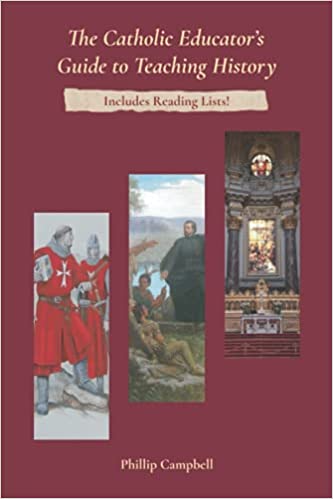Phillip Campbell teaches history to high school students through Homeschool Connections, and he is the author of the TAN Books series, Story of Civilization. In The Catholic Educator’s Guide to Teaching History, Campbell draws from his wealth of experience to share both principles and practical suggestions for teaching history. He speaks primarily to Catholic educators who teach in group-class settings, whether those be traditional Catholic schools, homeschool co-ops, or other venues.
Much of what he discusses also applies to parents teaching their own children at home. For example, in the second chapter, “History at Different Age Groups,” he explains why children in the elementary grades should learn about people, children in middle school should learn about events, and high school students should learn about ideas.
This understanding of how different age groups absorb information is critical since it helps us understand why cycling through all of history three times over twelve years is generally the most effective approach. Second graders can listen to stand-alone stories about Charlemagne. Sixth graders will learn about his conquests, how he united much of western and central Europe, and that he was crowned by Pope Leo III as the Holy Roman Emperor. High school students will learn about the significance of the papal crowning, the politics involved in the relationships between popes and emperors, and maybe consider the spiritual advantages and disadvantages of the alliances between them.
While the repeated historical cycles are ideal, the historical era that a student needs to study in a particular year might be dictated by other factors. Chapter Ten discusses other factors that should be considered in determining your scope and sequence.
Campbell recommends that students memorize key dates, and to that end, he includes lists of some of the most important dates to be learned for each of the three levels: elementary, middle school, and high school.
Of more use to those teaching group classes are the chapters where Campbell provides advice on how to present history lectures, including how to present lectures that make it easy for students to take down useful notes. He also discusses topics such as the importance and value of incorporating primary source documents, and this ties into the subsequent chapter about historical bias. Campbell points out that using primary sources helps to avoid problems that crop up because of a teacher’s bias. (Campbell has authored two high school history courses based on the use of primary source documents: The Catholic Middle Ages and The Rending of Christendom, both available from Cruachan Hill Press.).
The highlight of the book for many teachers and parents is likely to be the 30 pages dedicated to lists of recommended literature for students in the elementary grades through middle school. The lists include books written by both Catholics and non-Catholics, and the recommended books are divided by historical eras.
At 107 pages, this book is a quick read, which makes it much more likely that teachers and parents will actually read it and glean from it valuable advice for presenting history courses.









